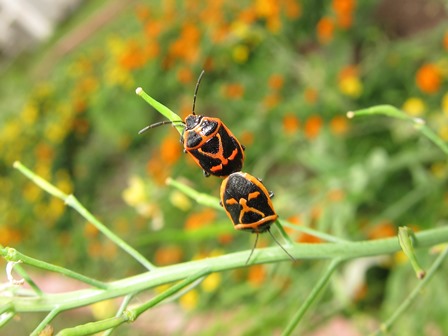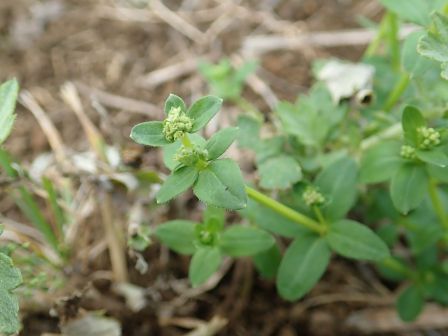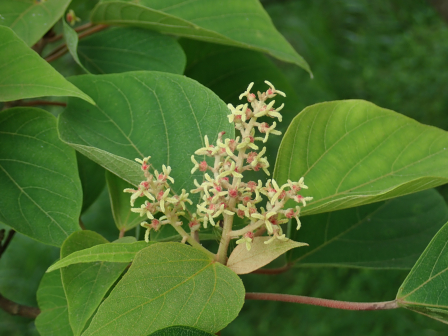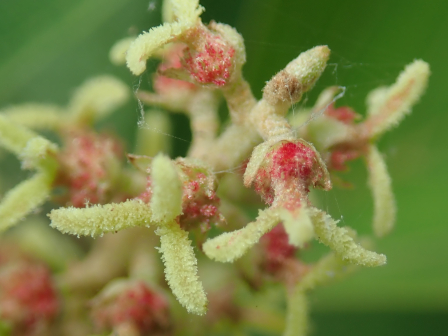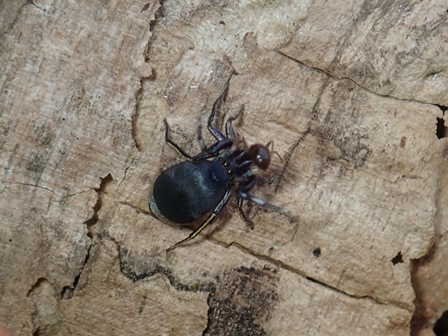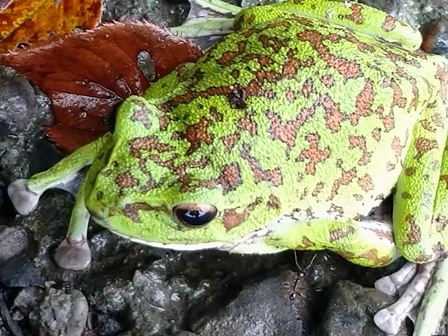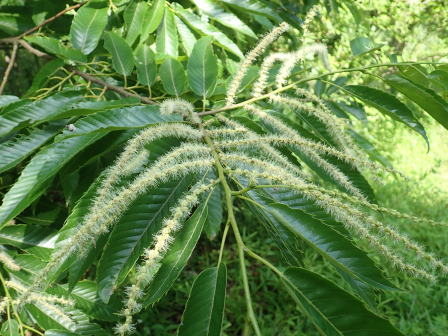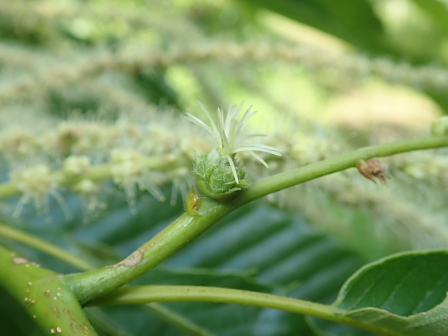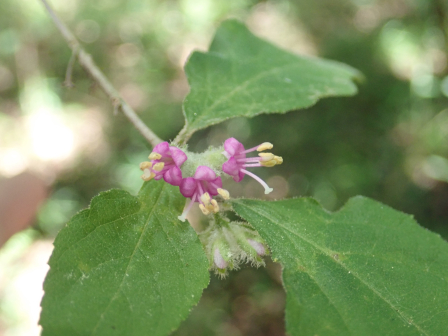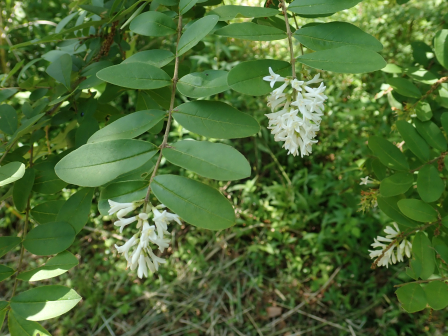フィールド日記
2022.07.08
ナガメ
花壇に植えていたカラシナにナガメがついていました。オレンジ色の綺麗なカメムシです。和名のナガメは菜の花につくカメムシという意味で、アブラナ科の植物でよく見られます。
I found "Nagame (ナガメ)" stink bugs on "Karashina (カラシナ)" plants in a flower bed. They are beautiful orange stink bugs. The name indicates that they can be often found on the plants belonging to the group of the "Aburana (アブラナ)" plants.
2022.07.05
ヨツバムグラ
ススキ野原にヨツバムグラが咲いていました。キャンパス内でいくつか同じ仲間の植物が見られますが、本種は明るい草地などに見られ、花序の柄が短く、花が密集して咲くことが特徴です。
"Yotsuba-Mugura (ヨツバムグラ)" plants are in bloom in the Japanese pampas grass field. You can see several similar species to this one in our campus. "Yotsuba-Mugura" plants grow in sunny grasslands and have short peduncles and bear flowers densely.
2022.07.01
アカメガシワ
共生の森でアカメガシワの花が咲いていました。アカメガシワは雄株と雌株に分かれていますが、この木は雌株です。
下の写真は雌花です。3つに分かれた黄色い柱頭が目立ちます。子房には若い葉と同様に赤い星状毛が密生し、赤く見えます。
An "Akame-Gashiwa (アカメガシワ)" tree is in bloom in the Kyoseinomori (共生の森). They are dioecious, which means that one tree has only either female or male flowers. This tree is a female one. The second photo shows female flowers. Three yellow stigmas are outstanding. Their ovaries look red because they are covered with red star-shaped hair, same as is also seen in thier read sprout covered by red star-shaped hair.
2022.06.28
アオオビハエトリ
カエデの木の上に、アリを食べているクモを見つけました。図鑑で調べたところアオオビハエトリのメスのようです。ハエトリグモは巣を作らず、飛びついて獲物を捕らえます。本種は特にアリを好んで食べるようです。
I found a jumping spider eating an ant on a maple tree. According to a reference book, this one is a female and is called "Ao-Obi-Haetori (アオオビハエトリ)". Jumping spiders don't build webs, so they jump to a prey and eat it. This species especially likes to eat ants.
2022.06.24
モリアオガエル
シスター大原に校内で撮影したモリアオガエルの写真を送っていただきました。モリアオガエルは池にせり出した木の枝などに、泡につつまれた卵を産みます。写真のモリアオガエルの指の吸盤を見てください。木を登るのに適した大きな吸盤をしているのがわかります。
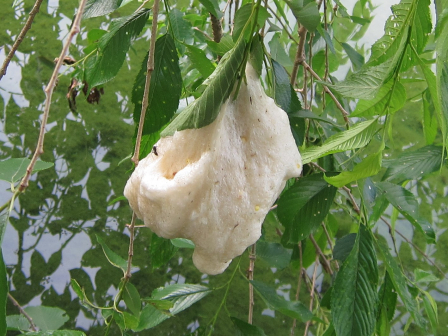
2022.06.21
ニッケイ
キャンプ場のニッケイの木の花が咲いていました。シナモンのなかまで、葉をちぎると独特な香りがあります。香辛料などに利用するため、かつてはよく栽培されていたようです。
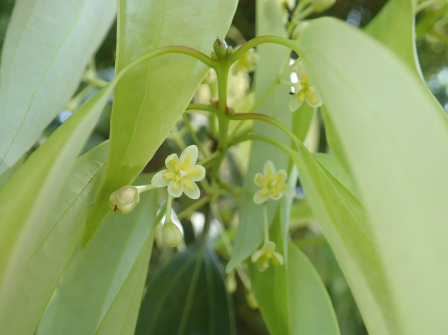
A "Nikkei" tree is in bloom in the campsite. They belong to the group of cinnamon trees, so tearing off leaves gives us a unique aroma. They were once commonly cultivated to use as spices.
2022.06.17
クリ
共生の森に植栽されているクリの木の花が咲いています。クリは雄花と雌花に分かれていますが、1本の木に両方咲いています。穂状にたくさん並んでいるのが雄花です。
雌花は下の写真のように、雄花の付け根のほうに咲きます。
"Kuri (クリ)" trees are in bloom in the Kyoseinomori (共生の森). They have distinct male and female flowers, but a tree has both flowers. The flowers aline in a spike are male flowers as you can see in the first photo. The female flowers bloom on the foot of the spike as you can see in the second photo.
2022.06.14
ニホンアナグマ
プールの近くにある倉庫の下に、動物の巣のように見える穴があったので、夜間に撮影できるカメラを設置したところ、ニホンアナグマが住んでいることがわかりました。下の動画は、撮影した画像をつなげたものです。
I found a hole looked like a nest of some animals near the school pool, so we put a night camera in front of the hole. We have found that Japanese badgers are living there. In the movie above, you can see the photos of the badgers taken by the camera.
2022.06.10
ヤブムラサキ
ヒノキ林でヤブムラサキの花が咲いていました。近縁のムラサキシキブとともに、秋に美しい紫色の果実をつけることで知られていますが、初夏に咲く花もかわいらしい花です。
"Yabu-Murasaki (ヤブムラサキ)" trees are in bloom in the Japanese cypress woodland. Like their close relative species "Murasaki-Shikibu (ムラサキシキブ)", "Yabu-Murasaki" are known for their beautiful purple fruit. However, the flower that blooms in the early summer is also pretty.
2022.06.07
イボタノキ
共生の森でイボタノキの花が咲いていました。和名は疣取りの木(いぼとりのき)が変化したものといわれています。この木に寄生するイボタロウカイガラムシが分泌するロウを疣(いぼ)をとるのに使われたことに由来します。
A "Ibota-No-Ki (イボタノキ)" tree is in bloom in the Kyoseinomori (共生の森). The name was originally from "Ibotori-No-Ki (イボトリノキ)", which means "wart-removing tree", and comes from the fact that people in the past used the wax produced by an insect "Ibota-Rou-Kaigaramushi (イボタロウカイガラムシ)" that parasitizes this tree for removing warts.


